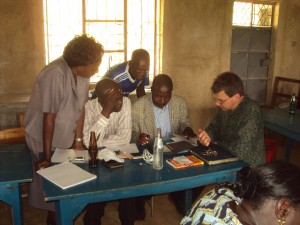One of the first major challenges for this project is how to address payments. Very few people in rural Kenya have bank accounts or credit cards. They don’t have much money either, the region is classified in financial terms as being at the bottom of the pyramid[1]. All this means we need to find alternatives to the ‘register your credit card or bank account for automatic billing’ approach often used in the USA, UK, etc.
In my view, Kenya has one of the most advanced micro-payment systems globally, through the m-pesa service and similar mechanisms from the various mobile network providers in Kenya. And micro-payments via mobile phones is ubiquitous in Kenya, including in the rural areas.
Publishers, rightly need to be paid for their work, unless they choose to provide the material without charge. So we have a conundrum, how to pay for the materials for the teachers… And for this project we shouldn’t assume the teachers, or their schools, can afford or pay for the material. A typical teaching book costs around $10 on Amazon.
We initiated the project by creating accounts for the schools where we provide some credit of £25 (around $40 USD) using gift certificates. The school teachers can then choose to use the credit to pay for several books, and there are lots of books, including the ‘classics’ available free-of-charge.
We need ways to defend against uncapped spending, a Kindle user does not need to authenticate themselves to buy items from Amazon, so they don’t need to enter a password or other security information – money is simply deducted from the credit balance or any linked credit card or bank account. Because we use gift cards and we don’t configure the Amazon accounts with either bank accounts or credit cards, the maximum financial risk is the remaining balance from the gift certificates.
We would like to find ways to enable teachers, and other people with access to micro-payment services in Kenya, to be able to contribute towards or entirely pay for eBooks and other items e.g. newspapers, journals, etc. The most popular micro-payment service is m-pesa from Safaricom, the other Kenyan mobile network providers have similar services. The report from iHub Research[1] provides some useful background information on the use of micro-payments. We have approached Amazon and various publishers and online book selling sites aimed at the Kenyan market to explore these possibilities. They would help to enable the teachers, and people involved in the schooling in the country, to take more ownership of the project.
Wishlists are part of the Amazon service. They provide an elegant way for whoever wants an item to track these requests and to share the requests with other people. In our case, the teachers are encouraged to add items to their wishlist, that’s linked to their Kindle account. We, and other people who would like to support the project can then pick books from the wishlist and pay for them. The requestor (a teacher in one of the schools in Kenya) then receives the book the next time they use the device to connect online. There are some restrictions for Amazon accounts on the Amazon UK site that make it harder for people to buy books for another Amazon account. As far as we know Amazon accounts on the USA site don’t have this restriction.
We would prefer the ability for people to buy Kindle books as gifts for other Amazon accounts, i.e. accounts that work like those on the USA site, as it makes the approval and purchasing more decentralised and enables it to scale further. For instance, a sponsor could fund various books for a school by picking them from that school’s shared wishlist, without any need for intermediaries.
Using wishlists is an effective way to spend the very limited funds wisely, particularly for shared devices, and currently each of our devices may be shared with around 10 teachers at a school.
Another effective mechanism is the ability to download a sample of Kindle books. The teacher can then read the first section of the book to help decide if the book is worth ordering. However we have noticed some samples have very little of the book’s content, possibly for copyright or other commercial reasons? When there is little content the teacher is effectively buying blind – i.e. without being able to read a useful sample first.
[1] The following report, written by iHub Research in Kenya, covers mobile phone usage at the base of the pyramid. It provides a good overview of many relevant factors for this project. It can be downloaded from the World Bank blog here. Other web sites have links to it too.





